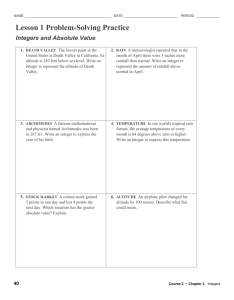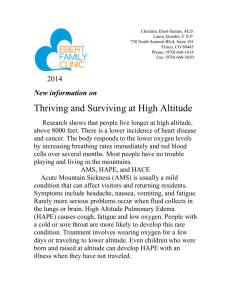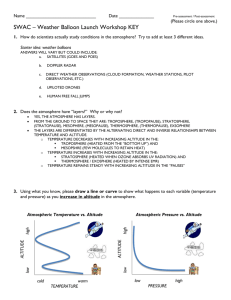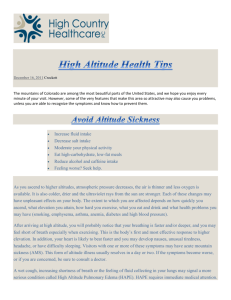LEAD-TO-LEARN - Millersville University: Meteorology
advertisement
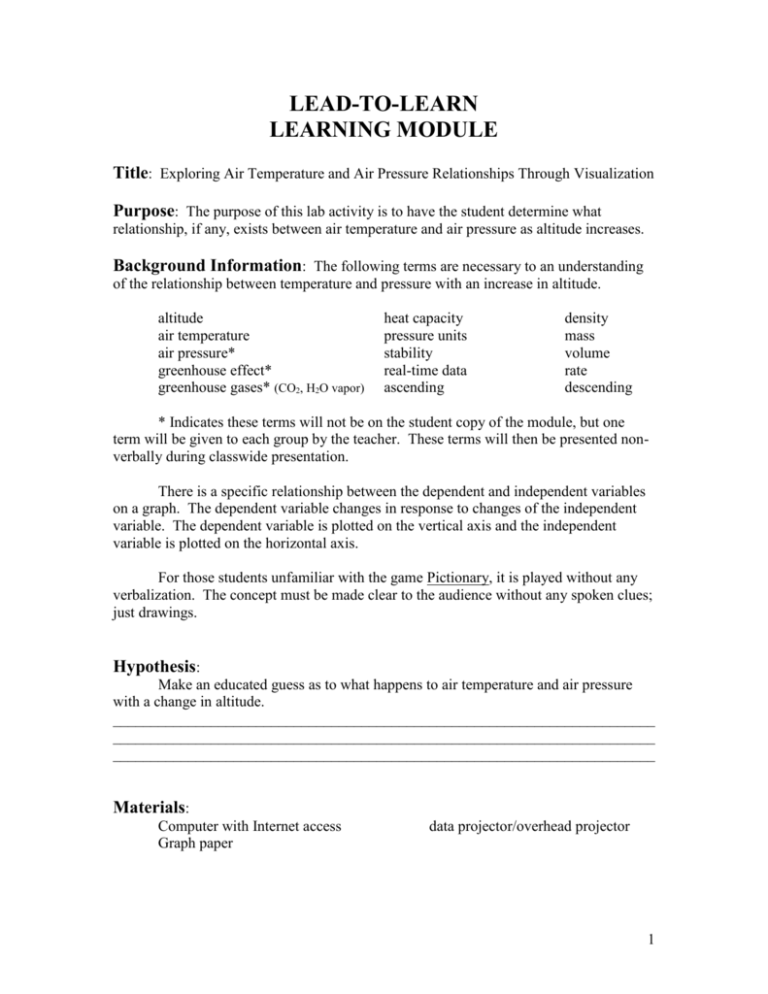
LEAD-TO-LEARN LEARNING MODULE Title: Exploring Air Temperature and Air Pressure Relationships Through Visualization Purpose: The purpose of this lab activity is to have the student determine what relationship, if any, exists between air temperature and air pressure as altitude increases. Background Information: The following terms are necessary to an understanding of the relationship between temperature and pressure with an increase in altitude. altitude air temperature air pressure* greenhouse effect* greenhouse gases* (CO2, H2O vapor) heat capacity pressure units stability real-time data ascending density mass volume rate descending * Indicates these terms will not be on the student copy of the module, but one term will be given to each group by the teacher. These terms will then be presented nonverbally during classwide presentation. There is a specific relationship between the dependent and independent variables on a graph. The dependent variable changes in response to changes of the independent variable. The dependent variable is plotted on the vertical axis and the independent variable is plotted on the horizontal axis. For those students unfamiliar with the game Pictionary, it is played without any verbalization. The concept must be made clear to the audience without any spoken clues; just drawings. Hypothesis: Make an educated guess as to what happens to air temperature and air pressure with a change in altitude. ________________________________________________________________________ ________________________________________________________________________ ________________________________________________________________________ Materials: Computer with Internet access Graph paper data projector/overhead projector 1 Procedure: 1. In small groups, seek out and research the definitions to each of the vocabulary terms in the Background Information section using the online AMS glossary. Each group will be responsible for presenting specific vocabulary terms to the rest of the class. This will allow for collaborative comparison of each term. Do not just copy the definitions. Be prepared to explain and discuss your assigned terms in your own words to the rest of the class. A PowerPoint presentation or overhead projections are suggestions for this presentation. The vocabulary terms annotated with an asterisk are to be presented as though playing Pictionary. 2. All students are responsible for recording and knowing all vocabulary with guidance from the instructor. 3. Individually create a hypothesis based on the title and purpose of this module and the vocabulary. 4. Since the purpose of this lab is to explore temperature, pressure and altitude relationships, this is the data which must be gathered. Each student will enter the LEAD portal to obtain real-time data. 5. Data is to be gathered from three separate locations in North America. Enough data should be obtained to adequately support your hypothesis. 6. Record your data in data tables similar to those in the Results section of this module. 7. Create graphs similar to those in the Results section of this module to show the relationships between the variables. 8. Respond to the questions posed in the Results section. These questions are designed to aid you in your analysis of this module. 9. Once the data has been gathered and recorded, you will individually be required to complete the Writing Prompt: “What happens to air temperature with a change in altitude and why?” Your response must be substantiated through the use of real-time data, data tables, graphs and logic. This is NOT a collaborative effort. Complete the Analysis section. 2 Results: Data Table 1: State the First Location Altitude Pressure Temperature ( ) ( ) ( ) Data Table 2: State the Second Location Altitude Pressure Temperature ( ) ( ) ( ) Data Table 3: State the Third Location Altitude Pressure Temperature ( ) ( ) ( ) Explain any trends or observations noticeable in this data table. ________________________________________________________________________ ________________________________________________________________________ ________________________________________________________________________ ________________________________________________________________________ ________________________________________________________________________ temperature temperature altitude air pressure What commonality exists between both graphs? ________________________________________________________________________ ________________________________________________________________________ ________________________________________________________________________ What relationship exists between air pressure and altitude? ________________________________________________________________________ ________________________________________________________________________ ________________________________________________________________________ 3 Analysis: As part of the analysis, complete the Writing Prompt. Your response should be clear and concise, yet long enough to fully explain your answer. Again, it must be substantiated through the use of real-time data, data tables, graphs and logic Writing Prompt “What happens to air temperature with a change in altitude and why?” Once you’ve completed an analysis of the data and the writing prompt, generate a 3 dimensional image of your data using the IDV software. Each student should be prepared to report their findings to the class. For the Teacher: Using a writing prompt makes this a cross curricular activity while also forcing a certain amount of logical thought. The use of the “why” in the writing prompt makes this a student driven activity. Using 3 different locations and real time data makes this a dynamic activity. Use of the IDV takes this activity from a typical “look up and draw the graph” activity to a visualization that allows for higher level learning. Once they have the relationship, the teacher can lead a discussion to normal and adiabatic (wet and dry) lapse rates. Data can be imported into an Excel spreadsheet and graph the cumulative data. Students should have obtained the data and reached the conclusion that air temperatures drop with increased elevation. Now they can figure lapse rates. They’ll all have different rates. Your class can come to a consensus regarding the relationship of air temperature and air pressure change with altitude. Using LEAD technology, you can compare your results with other schools. This module will serve as a precursor to modules on pressure systems, pressure gradient forces, instability and mesoscale meteorology. 4



